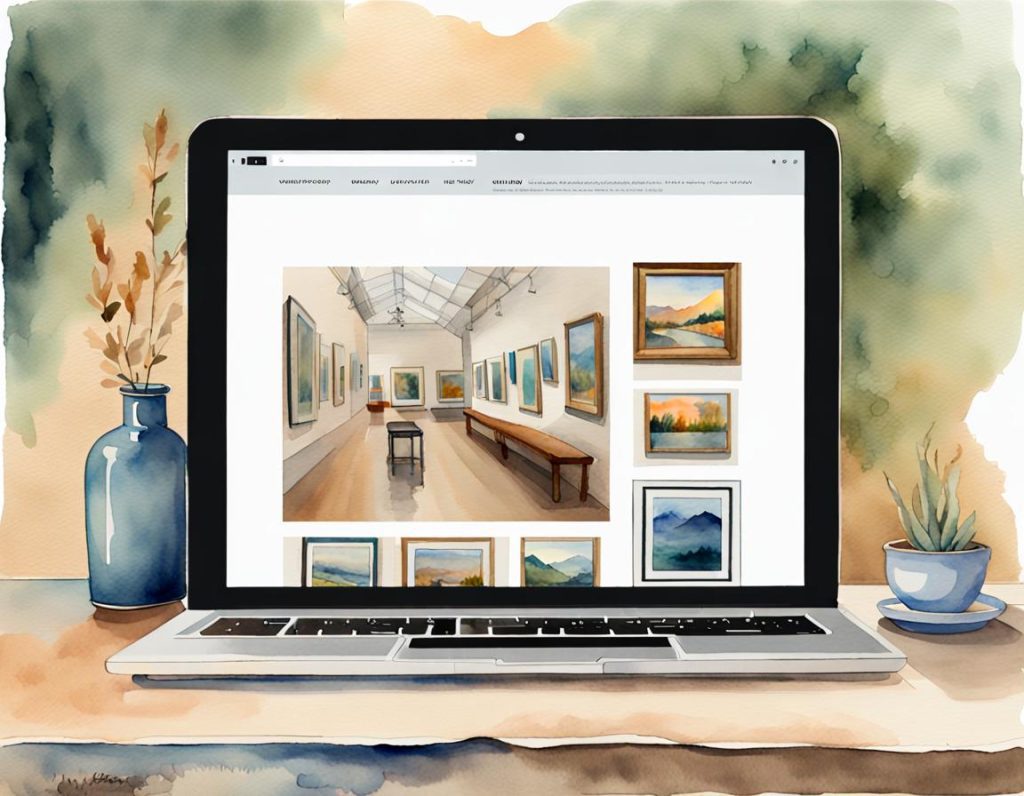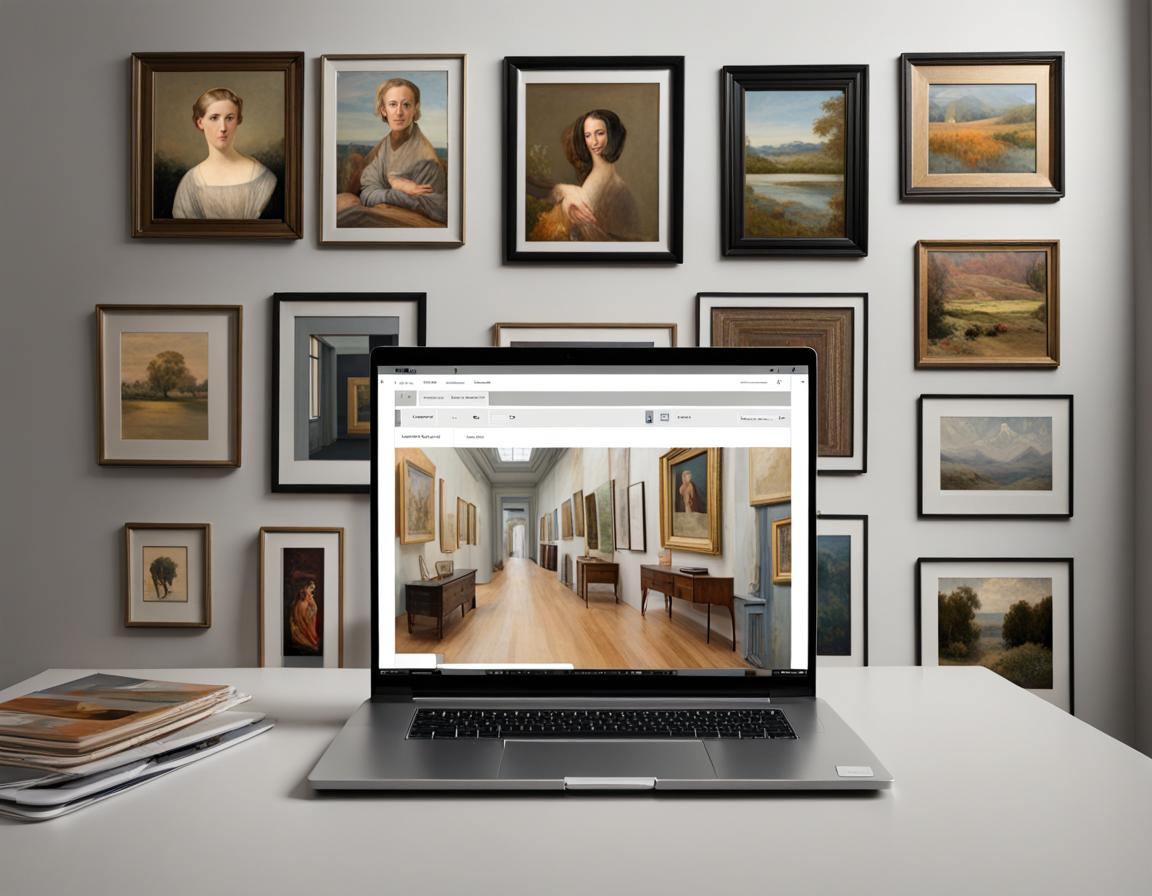In the digital age, having an online presence is crucial for promoting and showcasing your artwork. Creating a website dedicated to your artwork not only provides a centralized platform for potential buyers to explore your creations but also allows you to establish your unique brand identity. In this article, we will guide you through the process of creating a captivating website that effectively highlights your artwork and captivates your audience. If you are looking for more traditional marketing, read this guide: 10 Time-Tested Ways to Promote Your Artwork and Make a Splash in the Art World

1. Define Your Purpose and Target Audience
Before diving into the creation of your website, it’s important to define your purpose and identify your target audience. Ask yourself the following questions:
- What is the main goal of your website? Is it to sell your artwork, showcase your portfolio, or both?
- Who is your ideal audience? Are you targeting art collectors, interior designers, or a broader audience?
Answering these questions will help you shape the design, content, and overall structure of your website.
2. Choose a User-Friendly Website Builder
Selecting the right website builder is essential for creating a user-friendly and visually appealing website. Look for platforms that offer artist-friendly templates, customizable designs, and e-commerce functionality. Some popular website builders for artists include:
- Wix: Wix offers a wide range of artist-focused templates and intuitive drag-and-drop features. It allows you to create a visually stunning website even if you don’t have coding experience.
- Squarespace: Squarespace provides elegant and modern templates specifically designed for artists. It offers a seamless user experience and integrates seamlessly with e-commerce features.
- WordPress: WordPress offers more flexibility and customization options. It has numerous art-focused themes and a vast array of plugins to enhance your website’s functionality.
Choose a platform that aligns with your skill level, budget, and desired website features. However, one major disadvantage of these platforms, you are subject to conditions of use, and a possibility of losing your site (rare!). For the tech savvy, hosting your website on an independent hosting platform offers a full range of services plus added benefits of security. The WordPress software is freely available on most hosting companies. It is very easy to instal with full range of professional templates and plugins to improve and extend the site.
Video Getting Started with WordPress
3. Showcase Your Artwork with High-Quality Images
Your artwork is the centerpiece of your website, so it’s crucial to showcase it in the best possible light. Follow these tips for displaying your artwork effectively:
- Use high-resolution images: Ensure that your artwork images are of high quality and accurately represent the colors and details of your original pieces. Consider hiring a professional photographer or using a high-resolution scanner to capture your artwork.
- Organize your portfolio: Categorize your artwork into relevant collections or themes. Create separate pages or galleries for each collection, allowing visitors to easily navigate through your portfolio.
- Provide detailed descriptions: Accompany each artwork with a detailed description, including the title, medium, size, and any relevant stories or inspirations behind the piece. This adds depth and context to your artwork.
4. Create Compelling Content
In addition to showcasing your artwork, your website should communicate your artistic journey and unique story. Consider incorporating the following content elements:
- About Me page: Create an engaging “About Me” page that tells your story as an artist. Share your artistic background, inspiration, and any notable achievements or exhibitions.
- Artist Statement: Craft a compelling artist statement that reflects your artistic philosophy, style, and influences. This helps visitors connect with your artwork on a deeper level.
- Blog or News section: Consider integrating a blog or news section where you can share behind-the-scenes insights, art-related tips, or updates on your latest projects. This encourages visitors to return to your website for fresh content.
5. Implement E-commerce Functionality
If your goal is to sell your artwork directly from your website, it’s essential to incorporate e-commerce functionality. Choose a website builder that offers seamless integration with e-commerce platforms or plugins. This allows you to showcase your artwork, set prices, manage inventory, and handle transactions securely.
Ensure a smooth purchasing experience by optimizing your website for mobile devices, offering secure payment options, and providing detailed shipping and return policies.
6. Optimize for SEO
To improve your website’s visibility and reach a wider audience, optimize it for search engines. Incorporate relevant keywords throughout your website, particularly in page titles, image alt tags, and meta descriptions.
Consider writing blog posts or articles related to your artwork, using keywords and phrases that potential visitors might search for. This helps attract organic traffic to your website.
7. Engage with Your Audience
Encourage visitor engagement by incorporating various interactive elements on your website:
- Social media integration: Display social media icons and links to your profiles, allowing visitors to connect with you and share your artwork easily.
- Contact information: Provide clear contact information, including an email address or contact form, so visitors can reach out to you with inquiries or commission requests.
- Guestbook or testimonials: Include a guestbook or testimonials section where visitors can leave feedback or testimonials about your artwork and their experience.
Creating a captivating website for your artwork is an exciting journey that requires a careful balance of visually stunning design, engaging content, and user-friendly functionality. By following the guidelines outlined in this article, you can create a website that effectively showcases your artwork, engages your audience, and helps you establish your unique brand presence in the digital space. Remember to regularly update your website with new artwork, blog posts, and relevant content to keep your audience engaged and attract new visitors. Good luck with your artistic online journey!
Frequently Asked Questions (FAQ)
1. How do I drive traffic to my art website?
Driving traffic to your art website involves a combination of strategies. Here are a few effective methods:
- SEO optimization: Optimize your website with relevant keywords, meta tags, and descriptive alt tags to make it more visible to search engines.
- Social media promotion: Share your artwork on social media platforms, engage with your audience, and use relevant hashtags to reach a wider audience.
- Email marketing: Build an email list and send newsletters or updates about your latest artwork, events, or promotions to your subscribers.
- Collaborations and partnerships: Collaborate with other artists, art communities, or influencers to cross-promote each other’s work and reach new audiences.
2. How do I price my artwork on my website?
Pricing artwork can be challenging. Consider these factors when determining your prices:
- Artistic experience and reputation: Take into account your level of experience, exhibitions, awards, and recognition in the art world.
- Artistic size and complexity: Larger or more complex artworks generally command higher prices.
- Art market and demand: Research the art market and compare prices of similar artworks to understand the demand and price range.
- Costs and time invested: Factor in the cost of materials, time spent creating the artwork, and any additional expenses.
Remember to regularly reassess and adjust your prices based on market trends, demand, and the value of your work.
3. How can I protect my artwork from being stolen online?
While it is difficult to completely prevent online art theft, you can take certain measures to protect your artwork:
- Watermark your images: Add a visible watermark to your artwork images, making it harder for others to use them without permission.
- Disable right-clicking: Modify your website settings to disable the right-click option, preventing visitors from easily saving your images.
- Use low-resolution images: Display lower resolution images on your website to discourage unauthorized use for high-quality prints.
- Copyright your work: Consider registering your artwork with the relevant copyright authorities to establish legal protection.
4. How can I make my art website stand out from the competition?
To make your art website stand out, focus on developing a unique brand identity and offering a memorable user experience. Here are a few tips:
- Distinctive design: Create a visually appealing and intuitive website design that reflects your artistic style and resonates with your target audience.
- Compelling storytelling: Share engaging stories, inspirations, and anecdotes behind your artworks to create emotional connections with your audience.
- Interactive elements: Incorporate interactive features, such as quizzes, contests, or virtual galleries, to engage and captivate visitors.
- Exceptional customer service: Provide prompt and friendly customer service, be responsive to inquiries, and ensure a seamless purchasing experience for your customers.
5. Should I sell prints or only original artwork on my website?
Selling prints of your artwork alongside original pieces can be a smart business strategy. Prints offer a more affordable option for art enthusiasts who may not be able to afford original artworks. This allows you to cater to a wider audience and generate additional income.
Ensure that your prints are high-quality reproductions and clearly differentiate them from the original artworks. Clearly communicate their limited edition nature, if applicable, and provide certificates of authenticity to maintain transparency and value for your customers.


